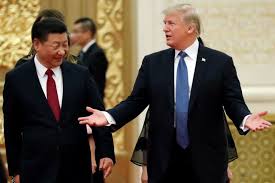Markets Daily: An update on US-China phase one trade deal

On the Main Menu: Back in mid-February 2020, the US-China phase one trade deal came into effect. China committed to buy US$200bn worth of US goods and services between 2020 and 2021 with 2017 levels of trade as a base. This brought a pause in the trade tensions that have introduced recurrent volatility in financial markets for some time.
The progress on the committed targets is far behind. Just a reminder, according to phase one of the Economic and Trade Agreement Between the US and China, China was going to increase its imports of US products to US$200bn between 2020 and 2021 from 2017 levels. According to the Peterson Institute of International Economics, this implied a purchase of US$173bn.
By the end of July, China’s imports from the US totalled US$49bn, which is only half of the year-to-date target of US$101bn. The shortfalls for 2020 are in the following goods and services categories:
· Agriculture: US$10bn compared with a target of US$21.3bn
· Manufactured products: US$36bn compared with US$111bn
· Energy products: US$2.6bn compared with US$25.3bn target
· All other products make up 30% of China’s imports are not subject to a legal target. China’s imports were US$19.2bn, which is close to 30% lower than 2017 level over the same period.
All said and done, China is way behind from meeting its legal targets under phase one of the trade deal. This is a potential risk for an escalation of trade tensions in future, however, it remains uncertain how trade might look in the event of a Biden presidency after the US elections. Just a reminder on this, no US president seeking re-election has won it while the economy was in recession. Donald Trump is seeking re-election and the economy is in deep recession like no other and marred by significant political risks.
Who I am reading:
· Deep Work, an easy read on how to get the most out of each day. It’s fantastic, and I will sure have a different relationship with my phone, emails, and socials after finishing the book.
While you were sleeping:
· Bond yields are down in the US: 2Y (-0.7bp), 10Y (-1.6bp); and mostly up in Europe: German 2Y (+1.3bp), 10Y (+1.2bp); Italy 2Y(+3.1bp), 10Y (+5bp);
· Global equities were mostly down: MSCI ACWI (-0.3%), MSCI World (-0.1%)
· US markets are mixed: S&P 500 (-0.2%), NASDAQ (+1.0%)
· European markets are down: MSCI Europe (-0.6%), Euro stoxx (-1.0%), UK FTSE 100 (-0.6%), France CAC 40 (-0.7%), German DAX (-1.1%)
· Asian markets are up: MSCI Asia Pacific (-0.8%), China Shanghai composite (-0.2%), India Nifty (-2.2%), Japan topix (+0.8%) and Hong Kong Hang Seng (-1.0%).
· Latin America markets are down: Brazil (-3.5%), Mexico (-2.9%) and Chile (-0.6%).
· JSE is down -1.0%: Top40 (-1.0%), Large cap (-0.9%), mid cap (-1.8%), small cap (-0.4%), basic materials (-0.1%), mining (+0.2%), gold mining (+0.0%), platinum and precious metals (+0.8%), industrials (-0.9%), general industrials (-3.0%)
· Commodities are mixed: Brent crude oil (-1.2%), gold (0.0%), copper (-0.3%)
· Sovereign risk as measured by credit default swaps spreads (CDS) was mostly flat in emerging markets except in Brazil were its down half a basis point.
· In currency markets, the US dollar index (DXY) marginally declined by 0.2% along with a the Brazilian real (-1.9%), the Russian rubble (-0.1%). The rand is flat at 16.95 to the dollar.
Data today:
· Absa PMI, which is expected to show a decline to 50.9 from 51.2.
· Naamsa vehicle sales expected to show a contraction of 24.5% in August (released on 1st September) following a contraction of 29.6% in July.
· Global PMI figures across the Americas, Europe and Asia will be released.
Best regards
Isaah
